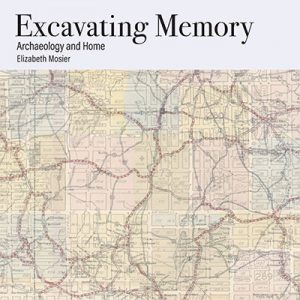Interview with Elizabeth Mosier
Interview by Maribel Garcia

Novelist and essayist Elizabeth Mosier logged one thousand volunteer hours processing colonial-era artifacts at Philadelphia’s Independence National Historical Park Archeology Laboratory to write Excavating Memory: Archaeology and Home (New Rivers Press, 2019). A graduate of Bryn Mawr College and the MFA Program for Writers at Warren Wilson College, her nonfiction has been selected as notable in Best American Essays and appears widely in journals and newspapers including Cleaver, Creative Nonfiction, The Philadelphia Inquirer, and Poets and Writers. She writes the “Intersections” column for the Bryn Mawr Alumnae Bulletin.
Drawing from her seven-year experience as a technician at Philadelphia’s Independence National Historical Park Archaeology Laboratory as well as her own personal experience, Elizabeth Mosier demonstrates how an archaeological approach can bring fresh insight to the writer’s craft. In her richly detailed memoir, Excavating Memories: Archeology and Home, Mosier gives readers a sense of her life as a mother, daughter, writer, and archeologist. Her hybrid memoir is beautifully written and is most notable for making the reader pay close attention to life’s regular (and sometimes) mundane details…details that are too often overlooked or discounted.
Garcia: I love that the memoir draws from both your seven-year experience as a volunteer technician at Philadelphia’s Independence National Historical Park Archaeology Laboratory as well as your own personal experience. By definition, archeology is the study of human history through the excavation of sites and the analysis of artifacts and other physical remains, and prose/narrative is unearthing and examining artifacts in an attempt to understand our humanity. Excavating Memory: Archaeology and Home is such a beautiful marriage of these two experiences. How did the idea to combine them come about?
Mosier: I was inspired to volunteer at the lab when I heard the head archaeologist, Jed Levin, speak about finding the foundation wall for the President’s house, calling it the “tangible link to the people who lived in this house, and a link between the enslaved and the free.” I signed on to process artifacts recovered from the site not because I planned to write about it, but because I wanted to help memorialize the nine enslaved Africans (Oney Judge, Moll, Austin, Hercules, Richmond, Giles, Paris, Christopher Sheels, and Joe Richardson) who lived in Washington’s house when Philadelphia was the United States capital from 1790–1800.
Though I’m not an archaeologist, it turns out that writing-related skills I possess—patience and nearsightedness—were exactly what was required. My supervisor, Deborah Miller, taught me lab procedures, answered my questions and recommended books, and generously shared her expertise. And inevitably, over the seven years I spent at the lab, I began to find connections between the work archaeologists do and the work writers do: digging, processing, and repairing the artifacts of experience in order to make meaning. This insight suggested a methodology I could adopt, an archaeologist’s lens I could apply to the people, places, and things I love and don’t want to lose.
My time at the lab coincided with my mother’s mental decline, due to Alzheimer’s disease. And so I also thought a lot about memory—how it frees and fails us—at the same time that Philadelphia citizens and civic leaders were sorting through cultural and historical memory as they planned the President’s House memorial that now stands on the site. It’s clear to me now, though it wasn’t then, that all that time processing artifacts allowed me to process “ambiguous loss”—to grieve for my mother, who was still alive but lost to me.
Excavating Memory: Archaeology and Home began to take shape as I wrote in my journal, recording details from my shifts at the lab, and reflections on memory. “The Pit and the Page,” an essay that braids the two experiences to express what it felt like the first time my mother didn’t recognize me, was the first I wrote for the collection. This essay opened the door to the possibility of a book.
Garcia: I don’t know what it is about memoir, maybe it’s the fact that any bit of personal or family history, large or small in scope, can throw light on the human condition. And we learn from that. How did you manage to write such a richly detailed memoir about being a writer, mother, daughter, and archeologist with such vivid memory for detail?
Mosier: I’m a curious person and a compulsive notetaker. I’m also careful to do research, to check my facts and fill the gaps in what I remember or experience. Which is to say that every line I write is reinforced by sources that serve as invisible scaffolding—but also that research is required to find how my personal experience might be meaningful to others. I write because it allows me to learn and convey what I’ve learned, always with the hope that I’ve expressed something useful to a wider audience.
 For this book in particular, working at the archaeology lab let me practice looking closely at small things, and beneath the surface of a city I knew mostly by its buildings, monuments, and celebrated citizens. Washing, labeling, mending, and cataloguing a colonial neighborhood’s glass fragments and ceramic sherds trained me to see broken, discarded things as material evidence—of social class, consumer patterns, cultural practices, politics, and relationships. I became more conscious of how we construct reality, create history, from pieces we’ve saved by choice or accident.
For this book in particular, working at the archaeology lab let me practice looking closely at small things, and beneath the surface of a city I knew mostly by its buildings, monuments, and celebrated citizens. Washing, labeling, mending, and cataloguing a colonial neighborhood’s glass fragments and ceramic sherds trained me to see broken, discarded things as material evidence—of social class, consumer patterns, cultural practices, politics, and relationships. I became more conscious of how we construct reality, create history, from pieces we’ve saved by choice or accident.
Paying attention to small but significant details—data recorded on artifact tags—made familiar things strange and therefore intriguing to me. I had to ask questions and do research to understand what I was looking at, which revealed the complexity in common things such as plates and bottles and other everyday objects. To write the book, I brought the beginner’s mind I had at the lab to my collection of personal artifacts.
Garcia: How did you go about structuring the memoir? You have a talent for making the reader pay close attention to life’s regular (and sometimes) mundane details…details that are too often overlooked or discounted. Here is an example:
“None of these [text] exchanges are particularly memorable—unless made ridiculous by autocorrect—but they are important to me. These messages, spontaneous and ephemeral, are markers of my real relationships, the moment-to-moment record of my life as it’s lived.”
I couldn’t read this without stopping to think about my own texts, the moment-to-moment records and markers that are just passing me by. As a writer, how do you pick what you will be writing about?
Mosier: I didn’t intend to write about my work at the lab or my mother’s Alzheimer’s. Now, not intending is part of my writing practice. When I’m on deadline, trying to produce something, I tend to forget what every writer knows: that curiosity can take us to more interesting places than we typically pick.
The most important thing I learned from the archaeologists is that the true treasure isn’t the artifact, but rather, the information gleaned from it. And after one thousand hours at the lab, I began to view my own material through this new lens. For me, the quiet task—the Zen-like tedium—of washing or labeling broken glass every other Thursday for seven years required just enough focus so that my imagination could roam free. But it was important that I recorded my observations and reflections in my journal, because I didn’t know what details were important, or what to do with them, until much later.
For example, the essay called “Believers” opens with an anecdote about a collector visiting the archaeology lab, a scene I captured in my journal. At the time, I wasn’t sure why I saved it; I only knew that the collector’s dismissive attitude toward the archaeologist’s work irritated me for some reason. Four years later, I came across the journal entry. By that point, other events had coalesced to resonate with this one, provoking a question I wanted to answer: What makes something “treasured”? I finally wrote the essay during my last year at the lab, when I had worked there long enough to identify with the archaeologists, to better understand our shared enterprise. As I wrote, “…artists and archaeologists will spend our lives searching because the process of searching is valuable.”
Garcia: Willa Cather once wrote, “Most of the basic material a writer works with is acquired before the age of fifteen.” I keep thinking about that big tree that you write about, the one that marked so much of your childhood and adolescence. You write:
“Certain artifacts from our pasts are discarded; others stay with us, charged with emotional power. I visit the Big Tree every time I’m in Phoenix; from my desk, I search for the God’s eye view of it on Google Maps. The tree often appears in my stories and essays, as itself or in disguise…”
Why do you think certain moments stick with us the most and what happens when we write about them?
Mosier: Memory might be fallible, but it’s also sticky. We remember what is of emotional value to us, even when—maybe especially when—we don’t understand why or what a particular memory means. Writing is how we make meaning from the odd bits, the artifacts of experience we’ve saved.
In the last ten years, I’ve had to empty five houses full of objects collected by departed family members—“grief cleaning,” I call it—which immersed me in thinking about why we keep the things we keep while we let other things go. For me, the decision to keep something is guided by a familiar visceral feeling that serves me when I’m writing, too: a somewhat mysterious but compelling sense that this is something I can use.
Garcia: There are so many gorgeous quotes in the book. I want to write them all down. The way that you write about your mother’s slow descent into dementia made me feel like I was right there with you. I was with my mother as she struggled with my grandmother’s dementia and your writing on the matter is something that I will definitely be coming back to—for guidance and support. You write:
“Writing is something like building a bottle from the base up using broken glass scattered on a table, glittering and inscrutable. And then taking it apart again to slowly fashion a story from the findings.”
Do you think that making meaning out of our stories is a form of therapy?
Mosier: I’m so sorry about your grandmother. Memory loss is devastating.
Ever since I was a kid, I’ve coped with sadness by making things. Though not all writing is therapy, making any kind of art has a therapeutic function; like grieving, writing is a process of putting severed parts together, restoring order from chaos. And yet, I was too distracted and distraught to write about my mother’s memory loss.
Only in retrospect can I see that volunteering at an archaeology lab gave me an oblique strategy to write from and about this traumatic experience. But really, any kind of slow, careful, process work you enjoy, like gardening or sewing, would offer the same benefit. For me, the regular, tangible practice of processing artifacts connected my mind to my senses, and therefore to my body, and thereby to my emotions. Likening grief to an archaeology dig—telling myself “it will take ten years to process it all,” as the archaeologists said about the more than one million artifacts they’d recovered—allowed me to appreciate the enormity of what I was trying to do, and to have patience with myself. By adopting the vocabulary of archaeology, I could write about trauma without re-traumatizing myself.
The past ten years have been, for me, a long process of recovery. This book of essays is an artifact, forming the record of my midlife reconstitution in the wake of loss.
Interview originally published on Book Club Babble

